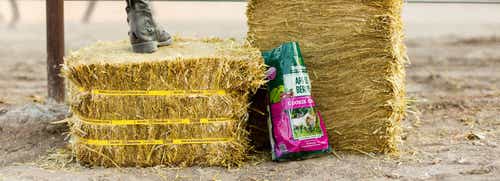
How to Safely Put Weight on a Starved Horse
Have you ever taken in a horse that has been starved? A truly starved horse – not one that’s just a bit underweight, but one that’s significantly underweight – requires a specialized and careful nutritional approach in order to regain both weight and health. If you, or someone you know, ever decide to take on a starved horse, be sure that you’re familiar with the information below.

Refeeding Syndrome
When horses have been starved, their bodies have run out of fat and carbohydrates to use for energy production. Instead, they have begun to break down protein from muscle as well as body tissues, like the heart, in order to power their metabolic processes. This leaves the horse in a highly dangerous state.
As food and good nutrition are reintroduced, these horses can suffer from a condition called “refeeding syndrome.” Concentrated calories, such as those in grain, can cause kidney, heart, and respiratory failure. This is usually seen between 3 and 5 days after the horse is given his first meal of grain.
The Refeeding Protocol
To combat this issue, the University of California Davis Center for Equine Health created a small research team to determine just how to most safelythe safest feed program for starved horses. Through experimentation, the team created a refeeding program that is recommended (and widely used) to refeed horses that have been starved.
According to the UC Davis Refeeding Program, starved horses do best when initially fed frequent small meals of a high-quality alfalfa. During each feeding, you can slowly increase the amount of alfalfa fed, while also gradually decreasing the number of feedings that you provide over the initial 10-day period.
Once a horse has been on this regimen for between about 10 and to 14 days, you can feed the horse as much as he will eat, and in larger meals. According to the study, it typically takes between 3 and 5 months to fully rehabilitate a horse to his previous weight.

Additional Considerations
If you take on a starved horse, your first priority should be to schedule a thorough veterinary examination to identify any health issues that the horse may be experiencing. You should discuss your refeeding program with your veterinarian, who can advise you on any risk factors that may affect your individual horse, since no one horse is the same.
You will want to check to see if the horse needs dental treatment, and your vet should be able to recommend a deworming protocol, as well as when to put establish that protocol into place (you may need to wait until the horse is a bit stronger and in better health before deworming). Other issues, like gastric ulcers or the presence of a metabolic issue, can also pose a challenge in putting weight on a horse, so be sure to discuss these with your vet.
Feeding a starved horse takes time, patience, and attentive monitoring of the horse’s condition. A horse that has been starved can be in a life-threatening situation, so work closely with your vet to track your progress and make sure that you’re on the right track.










